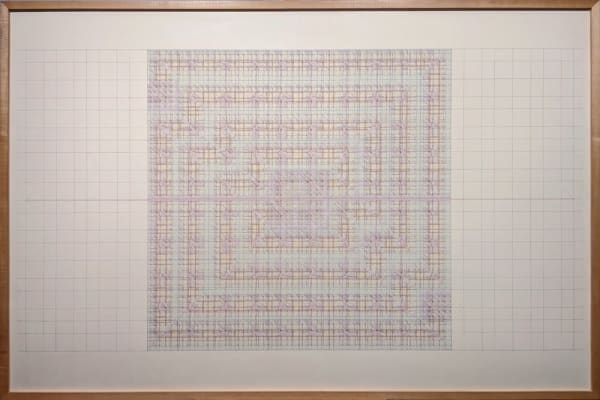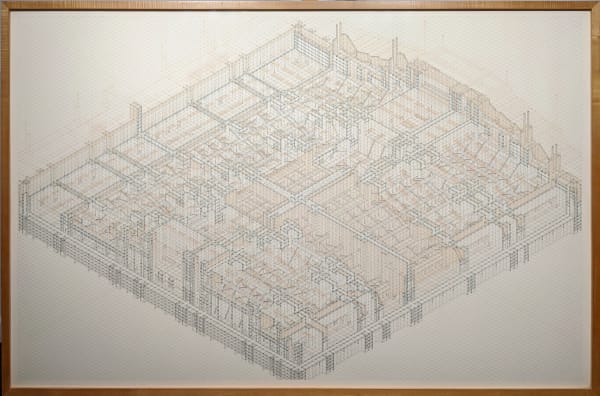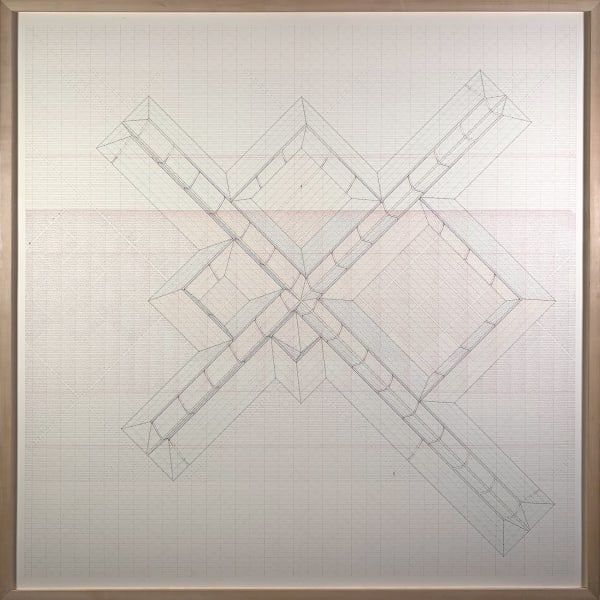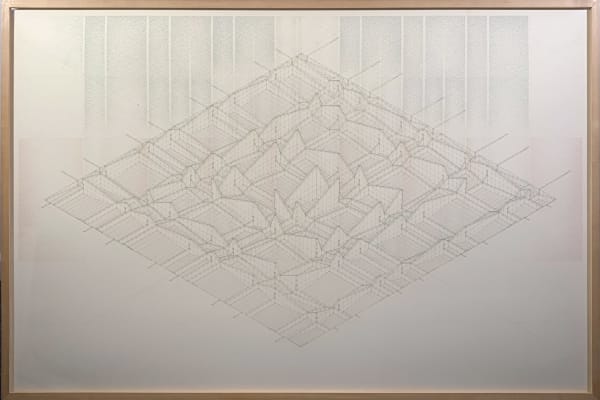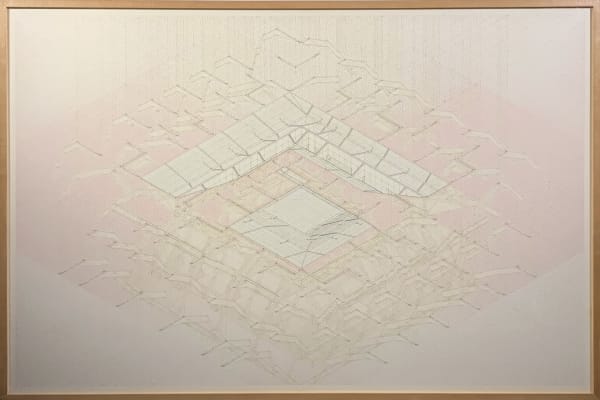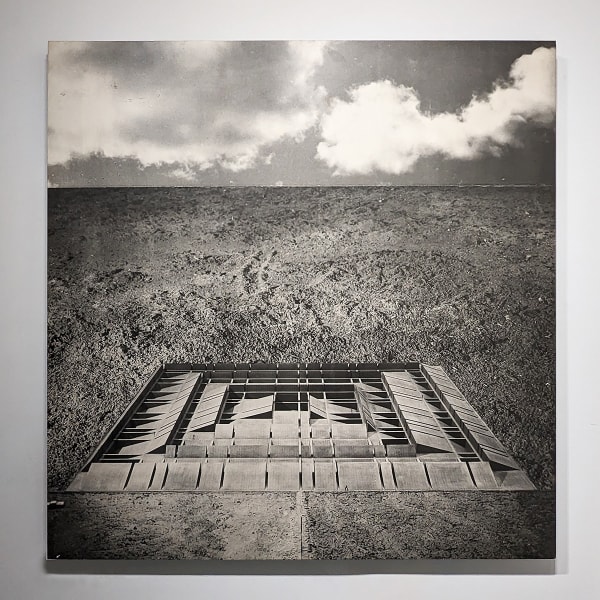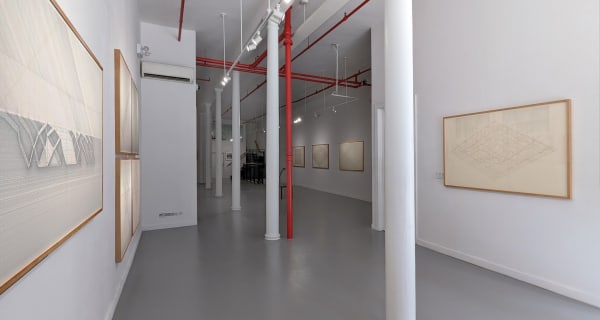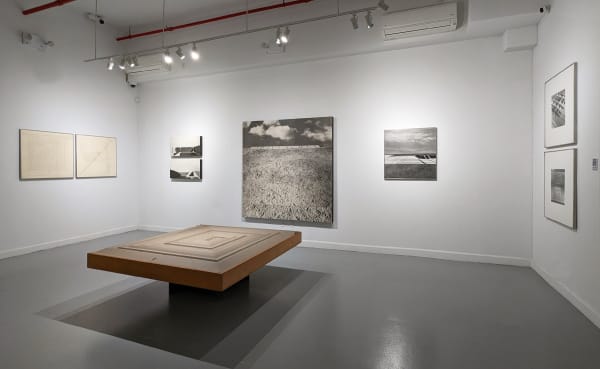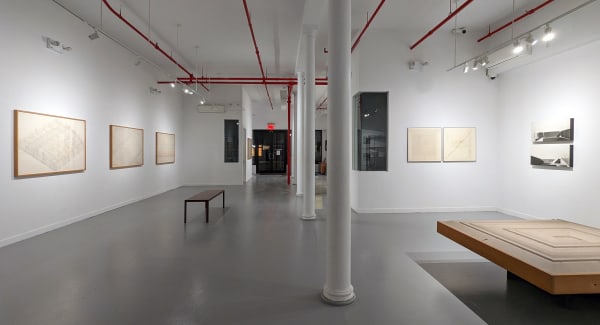Will Insley: Visions of a Future Civilization
WESTWOOD GALLERY NYC presents Will Insley: Visions of a Future Civilization, a solo exhibition of drawings, photomontage, and sculptural models, curated by James Cavello and on view September 8 – November 4. The exhibition also marks the release of the first gallery catalogue on Insley’s life and work.
Insley (1929–2011) envisioned ONECITY, a mythical 675-square-mile metropolis that responded to questions of population density, environment, and survival. His works—shown at MoMA in 1971 and the Guggenheim in 1984—combine the languages of art and architecture to imagine spaces that are both abstract and symbolic.
-
 Will Insley, ONECITY Building Plan, 1978/82
Will Insley, ONECITY Building Plan, 1978/82 -
 Will Insley, ONECITY Building Room, Under-Building, Isometric, 1978/83
Will Insley, ONECITY Building Room, Under-Building, Isometric, 1978/83 -
 Will Insley, ONECITY Building A, Section A, Isometric, 1979-80
Will Insley, ONECITY Building A, Section A, Isometric, 1979-80 -
 Will Insley, ONECITY Building Room, Section Red-Green Elevation, 1978-81
Will Insley, ONECITY Building Room, Section Red-Green Elevation, 1978-81
-
 Will Insley, /Building/ No. 18, Passage Space Field, Gate 1, Plan Oblique, 1971-83
Will Insley, /Building/ No. 18, Passage Space Field, Gate 1, Plan Oblique, 1971-83 -
 Will Insley, /Building/ No. 26, Dream Space Behind a Façade, Dream 3, Plan Oblique, 1971-83
Will Insley, /Building/ No. 26, Dream Space Behind a Façade, Dream 3, Plan Oblique, 1971-83 -
 Will Insley, /Building/ No. 27, Stage Space Cluster, Plan Oblique, 1971-83
Will Insley, /Building/ No. 27, Stage Space Cluster, Plan Oblique, 1971-83 -
 Will Insley, /Building/ No. 33, Passage Space Mountain, Isometric, 1972-81
Will Insley, /Building/ No. 33, Passage Space Mountain, Isometric, 1972-81
-
 Will Insley, /Building/ No. 35, Passage Space 1248, Isometric, 1973-83
Will Insley, /Building/ No. 35, Passage Space 1248, Isometric, 1973-83 -
 Will Insley, /Building/ No. 41, Volume Space, Interior Swing Section Through, 1973-81
Will Insley, /Building/ No. 41, Volume Space, Interior Swing Section Through, 1973-81 -
 Will Insley, /Building/ No. 41, Volume Space, Interior Swing, Isometric, X-ray View, Through the Ground, 1973-80/81
Will Insley, /Building/ No. 41, Volume Space, Interior Swing, Isometric, X-ray View, Through the Ground, 1973-80/81 -
 Will Insley, /Building/ No. 38, Passage Space Field, Gate 2 Section, 1973-82
Will Insley, /Building/ No. 38, Passage Space Field, Gate 2 Section, 1973-82
-
 Will Insley, /Building/ No. 17, Passage Space Spiral, 1971
Will Insley, /Building/ No. 17, Passage Space Spiral, 1971 -
 Will Insley, /Building/ No. 17, Passage Space Spiral, Viewing from the Ground 1, 1971
Will Insley, /Building/ No. 17, Passage Space Spiral, Viewing from the Ground 1, 1971 -
 Will Insley, /Building/ No. 17, Passage Space Spiral, View from the Ground 2, 1971
Will Insley, /Building/ No. 17, Passage Space Spiral, View from the Ground 2, 1971 -
 Will Insley, /Buildings/ No. 19-20, Interior Building Corridor of Life Gate, View from the Ground, 1970-72
Will Insley, /Buildings/ No. 19-20, Interior Building Corridor of Life Gate, View from the Ground, 1970-72
-
 Will Insley: Visions of a Future Civilization | Installation View
Will Insley: Visions of a Future Civilization | Installation View -
 Will Insley: Visions of a Future Civilization | Installation View
Will Insley: Visions of a Future Civilization | Installation View -
 Will Insley: Visions of a Future Civilization | Installation View
Will Insley: Visions of a Future Civilization | Installation View -
 Will Insley: Visions of a Future Civilization | Installation View
Will Insley: Visions of a Future Civilization | Installation View -
 Will Insley: Visions of a Future Civilization | Installation View
Will Insley: Visions of a Future Civilization | Installation View -
 Will Insley: Visions of a Future Civilization | Installation View
Will Insley: Visions of a Future Civilization | Installation View -
 Will Insley: Visions of a Future Civilization | Installation View
Will Insley: Visions of a Future Civilization | Installation View -
 Will Insley: Visions of a Future Civilization | Installation View
Will Insley: Visions of a Future Civilization | Installation View -
 Will Insley: Visions of a Future Civilization | Installation View
Will Insley: Visions of a Future Civilization | Installation View -
 Will Insley: Visions of a Future Civilization | Installation View
Will Insley: Visions of a Future Civilization | Installation View -
 Will Insley: Visions of a Future Civilization | Installation View
Will Insley: Visions of a Future Civilization | Installation View -
 Will Insley: Visions of a Future Civilization | Installation View
Will Insley: Visions of a Future Civilization | Installation View -
 Will Insley: Visions of a Future Civilization | Installation View
Will Insley: Visions of a Future Civilization | Installation View -
 Will Insley: Visions of a Future Civilization | Installation View
Will Insley: Visions of a Future Civilization | Installation View -
 Will Insley: Visions of a Future Civilization | Installation View
Will Insley: Visions of a Future Civilization | Installation View -
 Will Insley: Visions of a Future Civilization | Installation View
Will Insley: Visions of a Future Civilization | Installation View -
 Will Insley: Visions of a Future Civilization | Installation View
Will Insley: Visions of a Future Civilization | Installation View -
 Will Insley: Visions of a Future Civilization | Installation View
Will Insley: Visions of a Future Civilization | Installation View -
 Will Insley: Visions of a Future Civilization | Installation View
Will Insley: Visions of a Future Civilization | Installation View -
 Will Insley: Visions of a Future Civilization | Installation View
Will Insley: Visions of a Future Civilization | Installation View
WESTWOOD GALLERY NYC presents Will Insley: Visions of a Future Civilization, a solo exhibition of twenty drawings, photomontage, and sculptural models. This exhibition is curated by James Cavello and is one of a series from the gallery core program which presents artist estates with a significant, yet overlooked, contribution to art history. The curation includes artworks from Insley’s 1971 solo exhibition at the Museum of Modern Art, New York. The presentation will also mark the release of the first gallery catalogue on Will Insley’s life and work (released October 2023). The exhibition will be open to the public September 8 – November 4, Tues-Sat, 10am-6pm.
Will Insley (1929-2011) was an American artist who channeled his visions of a future civilization. The exhibition highlights Insley’s drawings, photomontage, and sculptural models in two distinctions: (1) the isometric and cross-sectional drawings of ONECITY, and (2) the drawing, photomontage, and models of abstract /buildings/ (designated with slash marks to distinguish them from normal practical architecture).
Despite studying architectural thought, Insley chose to become an artist, and to reflect his visions as unique paintings, sculpture, and drawings. By realizing the limitations of the practice of architecture and the normally accepted art of the times (painting-sculpture), he instead chose to work as an artist by thinking as an architect, embracing an art-architecture hybrid. This enabled him to present his artistic concepts through the pure abstraction of both fields.
Insley’s ONECITY can be interpreted as an artist’s futuristic vision in response to the ever-present questions regarding growing population density, global warming, and climate change. His interpretations were expressed almost 40 years ago, when Insley spoke with Maurice Poirier from Artnews on the occasion of Insley’s 1984 solo exhibition at the Guggenheim Museum: “What [Insley] pondered is that American cities may eventually cease to function as dwelling places. People would live as nomads in the countryside until they decided to pool their resources and build a complex to accommodate them all—a last, desperate attempt to resolve their differences and ensure their survival.”
The drawings of ONECITY on view render the imaginary metropolis drawn in extraordinary detail with ink and graphite on 40x60-inch ragboard sheets. The mythical 675-miles-sq city is divided into 2 ½ mile square chains of individually joined buildings, each approximately the width of Manhattan and divided between an ‘over-’ and ‘under-’. A drawing in the exhibition, ONECITY Building Room, Under-Building, Isometric (1978-83), gives form to his foresight of the working part of the city, containing areas for commerce, education, justice, administration, and manufacturing.
The drawings of the abstract /buildings/ represent what lies beyond the outer city structure, buried in the wilderness outside of practical functions. Insley recorded that the “only reason for the /buildings/ existence is to contain spatial situations sympathetic to the religious beliefs of the civilization of ONECITY. This focuses on a worship of the horizon line and of a passing through a space in that line between the earth and sky and of then embarking on travel into and return from the future with future information.” The accompanying photomontage and sculptural models give the /buildings/ real form. /Building/ No. 17, Passage Space Spiral (1971), previously exhibited in Insley’s 1971 solo at the Museum of Modern Art, includes tiny Giacometti-like sculptures walking amongst the structure indicating the /buildings/ precarious elevations and enormous scale.
All great artists seem to be possessed by a divine vision. Whether this vision comes from their experiences, philosophies, or artistic practices is up to the interpretation of the historian, the viewer, and in many cases can be found in the artists’ own words. Will Insley is one of these artists and experienced his artistic magnum opus ONECITY in complex visions from the 1950s-90s that interwove ideas of space, time, mythology, and abstraction. As his visions grew and became more elaborate, he began to discover all the sections of ONECITY: the Interior Building, the Opaque Library, the abstract /buildings/, and the metropolis’ main structure—a 675-sq-mile city situated between the Colorado Mountains and the Mississippi River. Although the purpose of the city remained unclear, he understood that it was the only one in America at this unknown future time. As he experienced each vision, Insley recorded his findings as artworks: ‘Wall Fragment’ paintings, photomontage depictions, and intricate drawings, some taking as long as ten years to complete. Additionally, he documented the book of the civilization, “Fragments from the Interior Building,” a poetically obscure diary and thesis containing information of ONECITY, its outer /buildings/, and religious musings.
Insley’s projects were informed by boyhood experiences in the open horizon of Indianapolis where he lived next to a big, empty modern house vacant for many years. As he explored the forbidden space, he experienced for the first time a house without a current practical function. When Insley went away to Amherst College in Massachusetts in 1947, he accidentally discovered and explored an underground labyrinth of tunnels that carried heating pipes, curiously traversing the dark areas over many nights. He continued his infiltrations in Cambridge’s alleyways, vacant buildings, and sealed fire escapes while attending Harvard’s Graduate School of Architecture. After graduating and after two years in the army, Insley moved to New York City, where one late night he found a door open after hours to Grand Central Station. Before being escorted out by a guard, he was able to roam the vaulted expanse alone to experience its grandeur. Shortly after, he began wandering the streets of New York night after night to study the grid and plot his mental map of New York City.
In time, Insley became interested in understanding more about such spaces, and taking his knowledge to a subconscious level in experiencing an entire civilization. As his attention turned inward, he became consumed with the memories of spaces located in some other time. The mind to him was another abstract architectural structure and he dedicated his entire life to exploring and answering his own questions about the realm we live in, past, present and future.
Viewed today, Insley’s ONECITY continues to surprise and reach a new generation with questions regarding the human experience in a metropolis and our current environmental developments that had yet to happen during Insley’s lifetime. As the first artist to explore the expansion of pure abstract architectural space to its limits, Insley had an extraordinary vision of our collective future.
WESTWOOD GALLERY NYC manages the artwork and archive of the estate of Will Insley (1929-2011).

